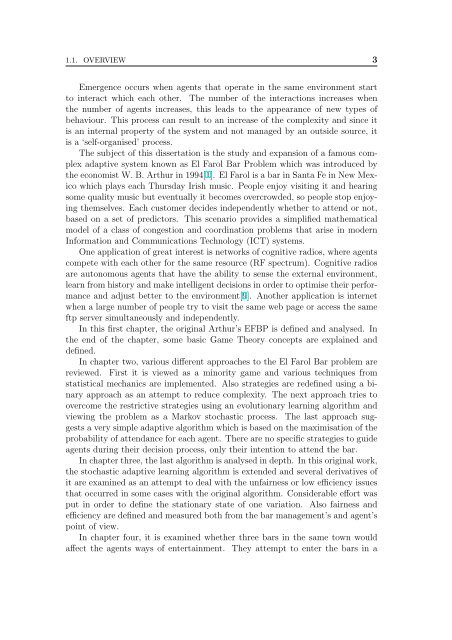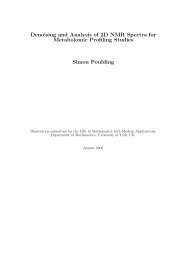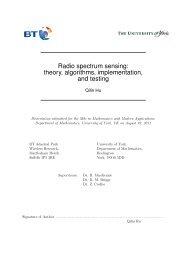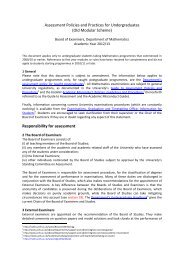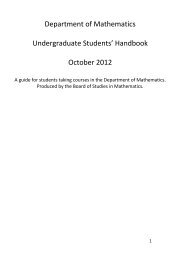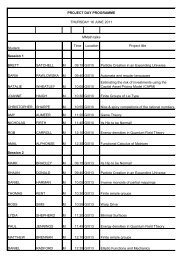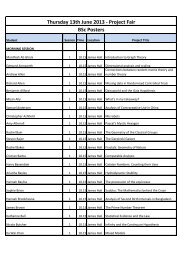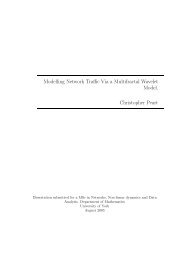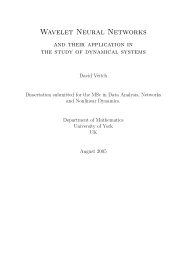The El Farol Bar Problem for next generation systems
The El Farol Bar Problem for next generation systems
The El Farol Bar Problem for next generation systems
Create successful ePaper yourself
Turn your PDF publications into a flip-book with our unique Google optimized e-Paper software.
1.1. OVERVIEW 3<br />
Emergence occurs when agents that operate in the same environment start<br />
to interact which each other. <strong>The</strong> number of the interactions increases when<br />
the number of agents increases, this leads to the appearance of new types of<br />
behaviour. This process can result to an increase of the complexity and since it<br />
is an internal property of the system and not managed by an outside source, it<br />
is a ‘self-organised’ process.<br />
<strong>The</strong> subject of this dissertation is the study and expansion of a famous complex<br />
adaptive system known as <strong>El</strong> <strong>Farol</strong> <strong>Bar</strong> <strong>Problem</strong> which was introduced by<br />
the economist W. B. Arthur in 1994[1]. <strong>El</strong> <strong>Farol</strong> is a bar in Santa Fe in New Mexico<br />
which plays each Thursday Irish music. People enjoy visiting it and hearing<br />
some quality music but eventually it becomes overcrowded, so people stop enjoying<br />
themselves. Each customer decides independently whether to attend or not,<br />
based on a set of predictors. This scenario provides a simplified mathematical<br />
model of a class of congestion and coordination problems that arise in modern<br />
In<strong>for</strong>mation and Communications Technology (ICT) <strong>systems</strong>.<br />
One application of great interest is networks of cognitive radios, where agents<br />
compete with each other <strong>for</strong> the same resource (RF spectrum). Cognitive radios<br />
are autonomous agents that have the ability to sense the external environment,<br />
learn from history and make intelligent decisions in order to optimise their per<strong>for</strong>mance<br />
and adjust better to the environment[9]. Another application is internet<br />
when a large number of people try to visit the same web page or access the same<br />
ftp server simultaneously and independently.<br />
In this first chapter, the original Arthur’s EFBP is defined and analysed. In<br />
the end of the chapter, some basic Game <strong>The</strong>ory concepts are explained and<br />
defined.<br />
In chapter two, various different approaches to the <strong>El</strong> <strong>Farol</strong> <strong>Bar</strong> problem are<br />
reviewed. First it is viewed as a minority game and various techniques from<br />
statistical mechanics are implemented. Also strategies are redefined using a binary<br />
approach as an attempt to reduce complexity. <strong>The</strong> <strong>next</strong> approach tries to<br />
overcome the restrictive strategies using an evolutionary learning algorithm and<br />
viewing the problem as a Markov stochastic process. <strong>The</strong> last approach suggests<br />
a very simple adaptive algorithm which is based on the maximisation of the<br />
probability of attendance <strong>for</strong> each agent. <strong>The</strong>re are no specific strategies to guide<br />
agents during their decision process, only their intention to attend the bar.<br />
In chapter three, the last algorithm is analysed in depth. In this original work,<br />
the stochastic adaptive learning algorithm is extended and several derivatives of<br />
it are examined as an attempt to deal with the unfairness or low efficiency issues<br />
that occurred in some cases with the original algorithm. Considerable ef<strong>for</strong>t was<br />
put in order to define the stationary state of one variation. Also fairness and<br />
efficiency are defined and measured both from the bar management’s and agent’s<br />
point of view.<br />
In chapter four, it is examined whether three bars in the same town would<br />
affect the agents ways of entertainment. <strong>The</strong>y attempt to enter the bars in a


